digging at HEMINGRAY
by Roger Lucas
Reprinted from "Crown Jewels of the Wire", June 1996, page 6
The road to the dump, or should I say, the alleyway to the dump, started with
good collector friend, Darin Cochran and I trying to acquire the limestone blocks
that contain the Hemingray Glass Company name from the old office building in
Muncie, Indiana a couple of years ago.
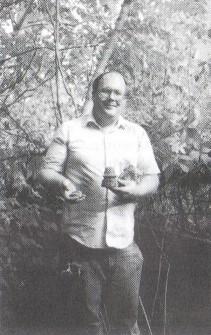
Once we found out from a contractor that the front wall would become
dangerous from removing the limestone, we cancelled the idea. But what we were
about to see would help diminish the loss of the sign. Before going home that
day, the Plant Manager at the time told us, among other things about the plant,
that there was broken glass “all over” the back of the property. Needless to
say, we asked for a look around. He went with us for a look at a few of the
buildings on the way to the back, including a full tour of the office building.
A long alleyway, going from the parking lot in the front to the rear of the
property, was our path. We were amazed at how many buildings and structures
there were, plus an underground tunnel connecting some of the rear buildings. We
got a look at a sand elevator, huge furnaces and kilns and a big Owens-Illinois
named control board with lights and switches all over it. There were also two
large Toledo scales in the sand elevator.
After this quick building tour, we ended up at the back of the property. We
walked across a weedy, sandy area with broken glass and insulators strewn
everywhere. First off, Darin finds a solid pour!- probably a CD 121. I find the
top 2/3’s of a CD 162 H.G.Co. in purple, right on top of the ground! I started
to sweat, and it was April! We walked around the retaining walls and in a couple
places there were spaces between the blocks, which were old furnace wall blocks
with multicolored glass coating them. There were insulators literally pouring
out notably D-990’s which apparently survived intact due to the nature of
their dense design. Well, leaving that day was hard to do, but we were
determined to return.
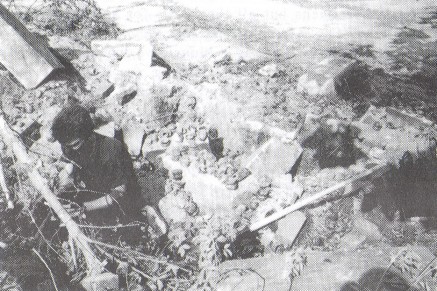
Darin digging around retaining wall
with ground strewn with D-990's.
After the winter and spring passed, I contacted the manager to get permission
to dig the dump. I made sure that it was okay as well with the owners of the
property. The one who owns the plant is a corporate attorney and trucking
company-warehouse owner, so I was careful not to step on any toes-- especially
his. Once permission was obtained, our first full day on the dump was like being
on holy ground! I felt like kneeling and kissing the dump, but instead, with
shovels in hand, we began what would turn out to be seven great weekends in the
summer and fall. We started at the furthest retaining wall, which was made of
the furnace blocks, and dug right behind them. This is where D-990 heaven was. A
couple of feet down, through glass and sand we found “veins” of D-990s.
Occasionally we found complete and nearly complete D-512s with extended inner
skirts, D-514s, Hemingray blue smooth base Hemingray-42s and several solid pours
of D-512s, D-514s and D-990s. There was also a bunch of Hemingray No. 103
spools, most of which had deformed holes and some leaners. It was here Darin
found the “big jewel”. A CD 155.6 Hemingray in 7-up green! It was only the
top 2/3’s, but what an oddball. It’s tough to top that but three 7-up green
D-990s could be great runners-up. They are specimens but all they have for an
embossing is “Hemingray” - no "D-990". (See cover photos below.)
Each time we came up to Muncie we dug a different part of the dump. An
interesting spot in a corner by a cement retaining wall and brick building
contained what we would name the “cobalt corner”. Literally tons of cobalt
glass chunks and broken H.G. Co. and Hemingray insulators. (See photo of Roger
at the beginning of the story holding a complete cobalt Hemingray signal and
chunks and pieces.) Now picture this - an eight foot high wall holding back
cobalt glass, dirt, sand and small trees. Some chunks we got there weigh up to
55 pounds. I found a mostly complete Hemingray-19 and a partial solid pour. Most
insulators found were halves of CD 162s. Digging through glass with a shovel is
tough as we found out, so we didn't get beyond two feet down in “cobalt corner”.
An adjoining area to the cobalt spot was filled with odd yellow-green glass and
Hemingray-19s with RDP in that same color. A scattering of yellow-amber glass
was also present. This area was purely glass, so we couldn’t get too deep
there either. The main part of the dump contained mostly aqua and clear glass
chunks and insulators, but had a sprinkling of purple H.G.Co. signals - top
halves mostly. A few of the ones we found have no dots between HGCo, a unlisted
variant in purple. As far as my specialty of collecting (embossing errors), that’s
right up my alley.
The aquas in the main part of the dump seem to come in all descriptions.
Besides D-990s, Hemingray No. 15s, 42s, 103s, 16s, 514s, 512s and 109s were
there. The insulators were mostly broken and the chunks were surprisingly small,
as compared to what I would think would be harder to find--the ambers and
cobalts. Also, a few small opalescent and weird green chunks were found in the
main part.
Bits and pieces of glass objects were discovered all over--like light green
blocks that measure six inches by two inches and 3/4 inch thick, aqua
worm-shaped glass pieces and melted or deformed blobs of glass that don’t seem
to be solid pours, that have “Hemingray” and “Made in USA” on them. A
lot of various shapes seem to be from dropping glass mixtures on a floor or
other kinds of spills or dumping still molten glass out in the dirt and sand. My
favorite thing, which has since become a paperweight, is a piece of concrete
that has four different colors of glass, a piece of rusted steel, and part of a
Hemingray-12 that shows the entire word “Hemingray”.
In the seven weekends I’d say we picked up some 50 Hemingray 103 spools, 20
solid pours, a half dozen smooth base Hemingray 42s, about 200 mixed top halves
of cobalt, purple and yellow green CD 162s. Probably two tons of chunks rode
with us back home in our cars, not to mention a unknown weight in insulators and
pieces. The only equipment found were two different sizes of files. We also
located several glass building blocks that have the Owens-Illinois symbol and a
few with “H” all around the center. At some of the deepest points, bottles
were found. One is completely intact and all of them have either a “H” in a
circle or a square on the bottom. We saved several bottle bottoms as well that
have “H” and other markings. These bottles appear to be soda or beer bottles
and had been made in many different colors. Several ice cream glassware bottoms
were also located with no markings and one is a solid pour.
Darin really likes groundhogs now since one apparently felt a Hemingray-661
in flashed amber was in his way and booted it out on a pile of gravel and dirt
from underneath a concrete slab! Also, in the rush to get things in the cars and
go home, we didn’t notice the Hemiingray-42 “M” top half. I wish there had
been “veins” of those.
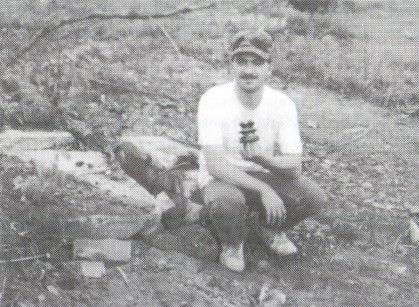
Darin and his "groundhog dug" Hemingray flashed amber
Our odyssey came to an end when the owners expressed a concern about
liability. They have a few businesses renting warehouse space there and the
owner’s trucking company is there as well. They figure if something happened
due to us being allowed in and not being employees, their insurance company
might not be too happy about it. Also, there is the present danger of all that
broken glass and older buildings for which the owner would not like to be held
liable in case of injury. We knew of course that day would come, so at the end,
we went on a kind of “glass grab”- picking up anything that didn’t move
and was made of glass. Chunks seem to be the favorite thing to get, then,
because we hadn’t seen something like that in such quantity before. Luckily, I
brought my camera to document the highlights of being there, since returning in
the future didn’t seem possible.
I thanked the owners for each time we got to go in and gave them an
assortment of good Hemingray insulators which I heard has found a home with
their son. Through several letters since, I tried to make a case for going back
and told them we'd sign our life away practically to show them we would not be
in the way or not harm the property and most of all, not claim anything against
them, but to no avail. There’s real history at that plant and dump in terms of
what different items Hemingray made, the varieties of insulators produced
including test or prototypes and how the plant was operated. We promised the
owners that we wouldn’t give out their names but to tell others that they do
have Muncie police protection and guard dogs to thwart off any unwelcome
intruder. They have told us since buying the plant they’ve had a few people
arrested for digging at night back there. I hope that wasn’t one of us good
collectors. Darin and I are thankful for the precious time we had at the dump
and do appreciate the limited permission to be at such a historical place, but
we also respect their right to protect their investment. Our hope is that some
avenue might be found to release that history to the insulator enthusiastic
public. It’s up to them.
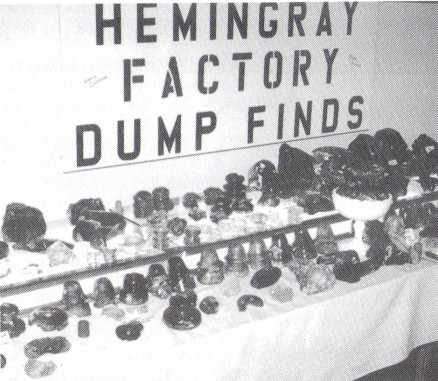
Some of our finds appeared at last year’s London, Ohio
NIA Central Regional show, and it was fun for us to “talk dump”
with many
collectors. Perhaps, some time, we’ll do it again.
|
Cover: Seven weekends of digging and thousands of
pounds of glass later...the cover of this issue features the diggers and
the glass!!
Roger Lucas of Columbus, Indiana and Darin Cochran of
Morgantown, Indiana experienced what many of the early Illinois, Indiana
and Ohio collectors knew in the late 60's and early 70's-- that much of
the history of Hemingray glass manufacture lay buried in the dumps of
Muncie.
I remember concluding a family vacation with a stop to talk with local
collector Ken Roach and following his directions to "the dump."
I'll never forget the two blonde McDougald kids carefully gathering up
pieces of insulators that were all over the top of the ground--no shovel
or pick required. I tripped over those buckets down in our basement for
years!
Two of the incredible specimens that were dug by Roger and Darin are
featured on the cover. The beautiful CD 155.6 Hemingray in 7-up green and
the CD 137 Hemingray D-990 also in 7-up green.
Roger plays "King on the Dump Debris" and is shown holding
the only complete bottle marked with an "H" on the bottom while
Darin finds himself in "cobalt comer" holding a CD 162 cobalt
signal and a partial solid pour. The details can be found beginning on
page 6.
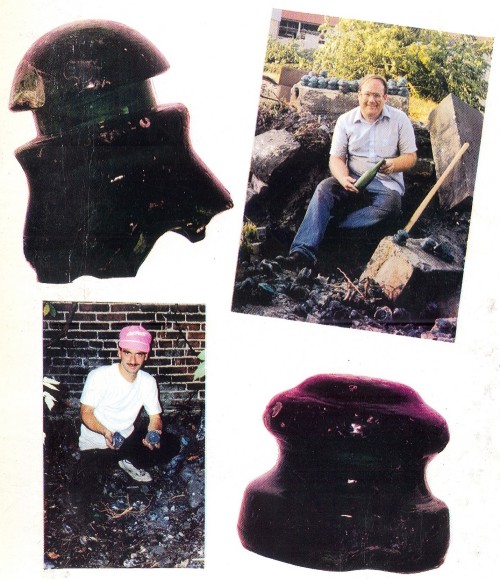
|
|
